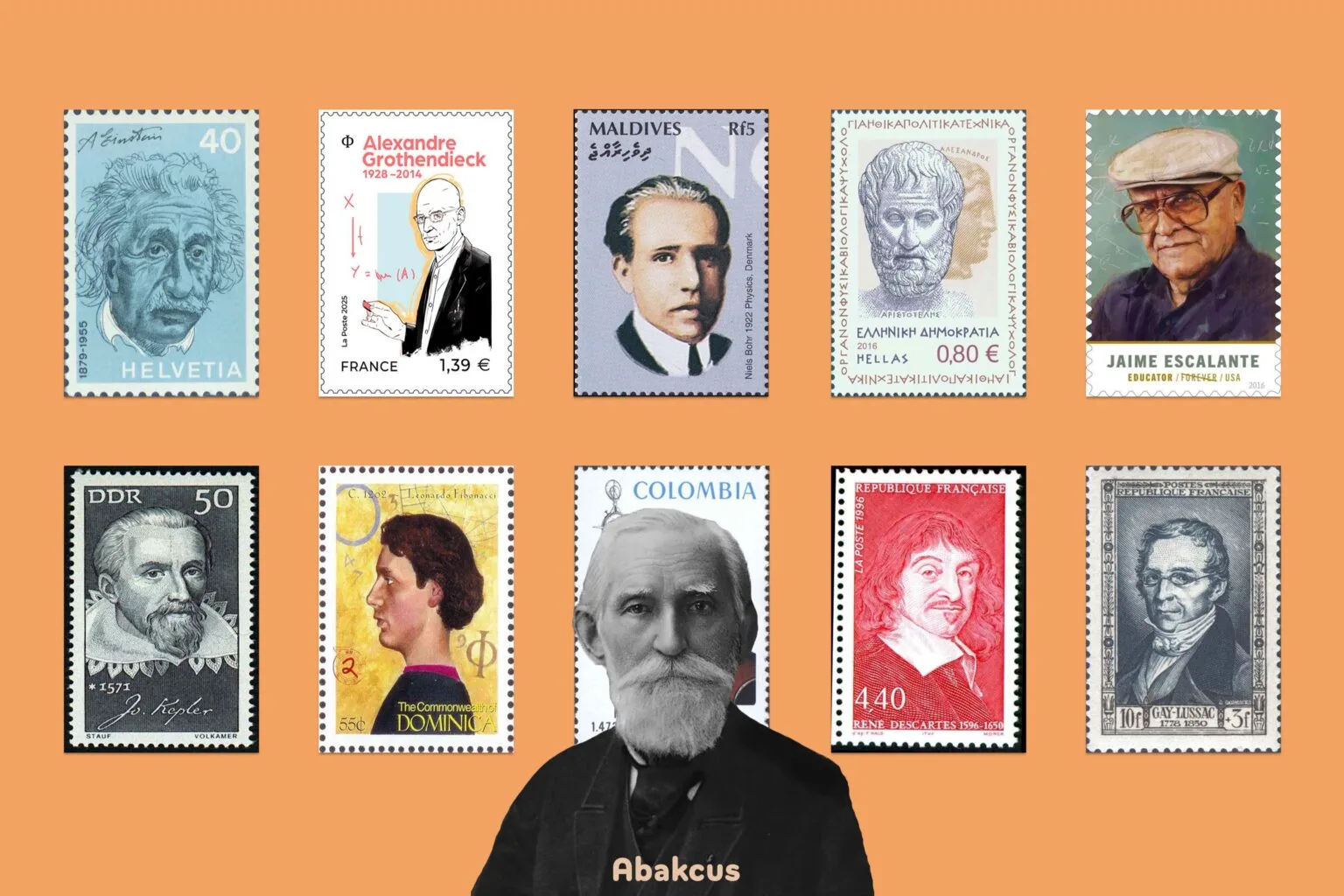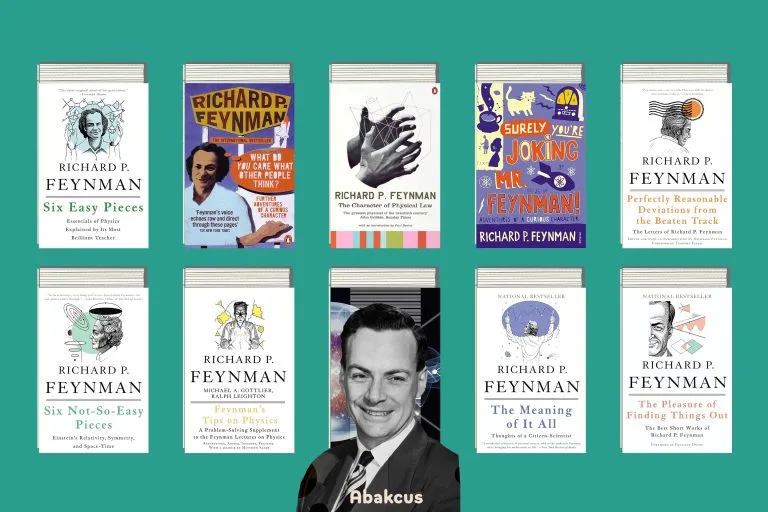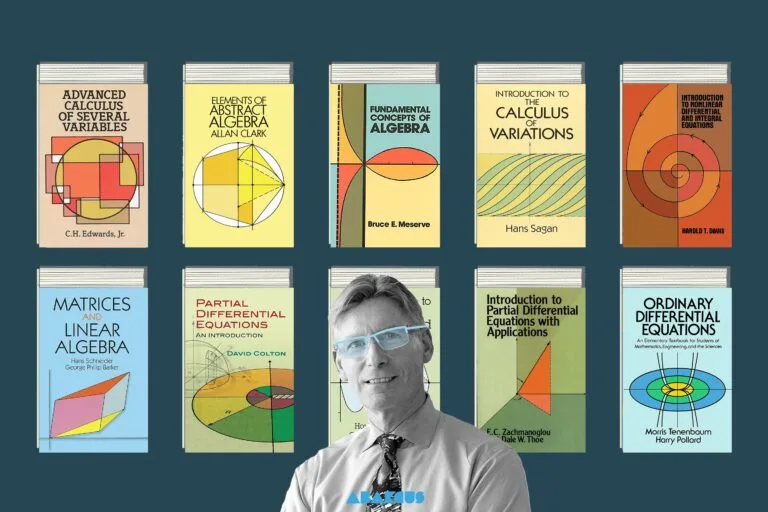Think about it: a postage stamp. Smaller than your thumbnail. Its whole purpose is to act as the state’s little “yep, this person paid” seal so your letter can travel. Basically, one of the most boring objects in the universe.
But humans are strange creatures. Someone inevitably asks, “Whose face should we print on this tiny piece of paper?” The answers are often predictable: kings, queens, presidents… Sometimes they spice it up with poets, artists, scientists. And every once in a while, a small miracle happens: mathematicians.
Yes, the bespectacled, bearded types who scribble weird symbols in the margins of notebooks. They too can end up on stamps. One day you see Gauss’s stern gaze staring back at you from Germany. Euclid holding a compass, silently saying, “My friend, you drew that triangle wrong.” Poincaré? He looks like he’s telling the mailman, “Space might be more twisted than you think.”
Let’s be honest: most of us don’t deal with postage anymore. Between email, WhatsApp, and delivery companies, stamps have almost vanished from daily life. And that’s exactly why stamp collections are like tiny time capsules. They hold the answer to the question: “Who did the world admire?” And the best part is, mathematicians are on that admiration list.
In this piece, I’ll show you how and why mathematicians found their way onto stamps. We’ll glance at the wrinkles on Gauss’s forehead, the golden spiral of Fibonacci, and the revolutionary ideas of Emmy Noether. And you’ll realize something: seeing mathematicians on stamps is humanity’s way of saying, “we owe these people a lot.”
Mathematicians on Stamps: Tiny Paper, Huge Brains
Ernst Abbe (1840–1905)
Most people hear “glasses” and just think of frames and lenses. Ernst Abbe heard “optics” and opened a window into the universe with a microscope. He took mathematics, embedded it into glass, and basically said, “Gentlemen, cells live here.” On the stamp he looks serious, but what he’s really saying is: “Yep, everything in your biology textbook passed through my equations.”
Niels Henrik Abel (1802–1829)
Imagine doing so much math before the age of 27 that, two centuries later, there’s a prize on par with the Nobel named after you. Abel pulled it off. He died young, but left algebra a giant note: “Some things just can’t be solved.” On the stamp he looks young and innocent, but he’s the guy who wrote mathematicians’ nightmares.
Al-Khwarizmi (c. 780–850)
If there’s a master behind computers, phones, and algorithms today, it’s this man: Al-Khwarizmi. His name turned into the word “algorithm,” he built the foundation of algebra, and he brought order to calculation. On the stamp, with his turban and stern look, he’s basically saying: “Your WhatsApp messages? Yeah, that’s me, buddy.”
Al-Biruni (973–1051)
A thousand years ago, this man measured the Earth’s radius so accurately that even Google Earth would blush. He was a trigonometry master who used science not just in theory but in practice. On the stamp he looks like he’s calmly saying: “Yep, I checked—Earth is a bit bigger than you thought.”
Al-Farabi (870–950)
The sage who blended math, philosophy, and music in a single mind—the original “multi-disciplinary” genius. On the stamp he sits quietly, but he’s probably thinking: “There’s an order to the universe, and I can turn it into both equations and melodies.” Can one man be a philosopher, a logician, and a music theorist all at once? If you’re Farabi, yes.
Al-Kindi (801–873)
The “first philosopher-mathematician rockstar” of the medieval world. He dabbled in cryptography and even thought about the kinship between numbers and music. On the stamp he’s holding a compass, but in his head he’s really saying: “Want to break codes? Come here, but first learn some logic.”
Nasir al-Din al-Tusi (1201–1274)
Imagine a mathematician who, even during the Mongol invasions, sat down and laid the foundations of trigonometry. Al-Tusi systematized the cosine law and rewrote astronomy. On the stamp he looks stern, but in the background his mind is busy saying: “Give me a little time and I’ll chart the motions of the universe.”
Albertus Magnus (1193–1280)
The “professor of professors” of the Middle Ages. He talked about everything: mathematics, logic, chemistry, botany… On the stamp, he raises his hand as if to say, “Children, listen to these postulates first.” Centuries before Google, he was the guy with all the answers.
André-Marie Ampère (1775–1836)
The man who tamed electricity with mathematics. You see his name every day in the unit of electric current: the ampere. The French were so proud that they put him on a stamp alongside his fellow scientist François Arago. In Ampère’s head, though, he’s probably thinking: “Without my formulas, your lights would go out.”
Archimedes (287–212 BC)
The genius who shouted “Eureka!” while taking a bath. He turned mathematics into physics, and physics into engineering. On the stamp he looks a bit rugged, but inside his head live infinite number lines, giant levers, and the principle of buoyancy. When he said, “Give me a place to stand and I will move the Earth,” he wasn’t joking.
Aristotle (384–322 BC)
The man who dug down to the foundations of everything. Logic? Biology? Mathematics? Philosophy? For Aristotle, they were all just pieces of one giant puzzle. On the stamp he looks serious, but the thought in his head is: “My friend, ask the right question first, and the answers will follow.”
Avicenna (Ibn Sina, 980–1037)
Doctor, philosopher, mathematician… basically the ultimate “jack-of-all-trades” of the medieval world. His medical book was taught for 600 years. In math, he linked geometry with physics. On the stamp he’s holding a plant, as if to say: “Yes, this herb heals, but without mathematics you’ll never really understand life.”
Charles Babbage (1791–1871)
The father of the computer. He imagined “machines that could calculate” and ended up changing human history. On the stamp, numbers are printed all over his head—pretty accurate, since his brain was literally the prototype of modern computers.
Stefan Banach (1892–1945)
There’s a whole branch of math called functional analysis—basically a new universe for mathematicians. Banach was its founder. On the stamp he looks a bit pixelated, which is fitting: he spent his life working in “infinite-dimensional spaces.”
Tadeusz Banachiewicz (1882–1954)
Astronomer, mathematician, keen observer. He was the star of the Kraków Observatory. He introduced new methods in trigonometric calculations. On the stamp, his serious face and thick mustache give gravitas, but you can bet he had plenty of fun dissecting the night sky through a telescope.
Friedrich Wilhelm Bessel (1784–1846)
He didn’t just do mathematics—he dissected the night sky too. The famous Bessel functions still pop up in wave equations today. On the stamp, they even put a graph behind him, basically saying: “This is what my brain looks like.”
Hans Bethe (1906–2005)
A Nobel Prize–winning physicist, but also the man who pushed mathematics straight into the heart of atoms. He helped us understand how the Sun burns. On the stamp he’s smiling broadly, and you can almost hear him say: “Yep, I figured out the secret of the stars, and I feel pretty good about it.”
Niels Bohr (1885–1962)
One of the bosses of quantum mechanics. He changed how humanity thinks about physics by explaining the structure of the atom. On the stamp he looks serious, but in his head electrons are dancing around like disco lights.
George Berkeley (1685–1753)
A philosopher-bishop who dove into the debate on infinitesimals. For him, “to be is to be perceived.” On the stamp he looks noble and formal, but you can imagine him saying: “Math or philosophy? Same thing to me, buddy.”
János Bolyai (1802–1860)
From a young age, he picked a fight with parallel lines. He became one of the founders of hyperbolic geometry, shaking the foundations of Euclid’s system. On the stamp he looks youthful and serious, but what he’s really saying is: “Guys, space is way weirder than you think.”
Friedrich Wilhelm Bessel (1784–1846)
He didn’t just do mathematics—he dissected the night sky too. The famous Bessel functions still pop up in wave equations today. On the stamp, they even put a graph behind him, basically saying: “This is what my brain looks like.”
Hans Bethe (1906–2005)
A Nobel Prize–winning physicist, but also the man who pushed mathematics straight into the heart of atoms. He helped us understand how the Sun burns. On the stamp he’s smiling broadly, and you can almost hear him say: “Yep, I figured out the secret of the stars, and I feel pretty good about it.”
Niels Bohr (1885–1962)
One of the bosses of quantum mechanics. He changed how humanity thinks about physics by explaining the structure of the atom. On the stamp he looks serious, but in his head electrons are dancing around like disco lights.
George Berkeley (1685–1753)
A philosopher-bishop who dove into the debate on infinitesimals. For him, “to be is to be perceived.” On the stamp he looks noble and formal, but you can imagine him saying: “Math or philosophy? Same thing to me, buddy.”
János Bolyai (1802–1860)
From a young age, he picked a fight with parallel lines. He became one of the founders of hyperbolic geometry, shaking the foundations of Euclid’s system. On the stamp he looks youthful and serious, but what he’s really saying is: “Guys, space is way weirder than you think.”
Eduard Čech (1893–1960)
The quiet hero of topology. Spaces, shapes, infinities—he brought order to all of them. Behind those glasses on the stamp, he seems to be saying: “Yes, I fold and unfold spaces… but only theoretically.”
Lazare Carnot (1753–1823)
A French engineer, mathematician, and general. He once asked, “Can war have mathematics?” and then went on to give strategy a geometric proof. The stamp gives him a military elegance; his inner voice probably says, “I can command an army the same way I solve an equation.”
Jean-François Champollion (1790–1832)
The man who cracked the Rosetta Stone. By deciphering Egyptian hieroglyphs, he gave humanity a new language for the past. On the stamp he’s drawn in profile beside the stone, looking serious—but you can almost hear him thinking, “I decoded an alphabet; humanity can finally read its own history!”
Anders Celsius (1701–1744)
The hero of plus and minus. He said, “Let’s measure heat,” and gave intelligence to the thermometer. On the stamp he stands before a temperature scale, quietly saying: “Every difference in warmth has its own math.”
Augustin Cauchy (1789–1857)
The prophet of rigorous logic in mathematics. Limits, integrals, functions—he brought structure to them all. His stamp includes his own formulas, because how else could you describe him? Cauchy’s mind was basically a clean-up operation for mathematics.
Nicolaus Copernicus (1473–1543)
By saying “the Sun is at the center,” he flipped the entire stage of the universe. While everyone else put Earth in the spotlight, he basically said, “Excuse me, but we’ve all been sitting in the wrong seats.” On the stamp he looks calm, but his inner voice is probably: “I just moved the Sun to the center—you guys are the ones overreacting.”
René Descartes (1596–1650)
The man who brought mathematics and philosophy to the same coffee table. He said, “I think, therefore I am,” but what he really meant was, “I invented the coordinate system—go ahead, start plotting things.” On the stamp, that sly smile says it all: “I know the plan.”
Richard Dedekind (1831–1916)
He took the idea of infinity seriously and reorganized the foundations of mathematics. Without Dedekind cuts, real numbers would still be a bit of a mess. On the stamp he stands next to his formula, almost saying, “With my face, numbers finally make sense.”
Christopher Clavius (1538–1612)
A Jesuit priest, astronomer, and mathematician — one of the architects of the Gregorian calendar. On the stamp he’s surrounded by books and globes, giving off total “I recalculated the world” vibes. Every time you see February 29th, remember: Clavius did that.
Paul Dirac (1902–1984)
The prodigy of quantum mechanics. He fused math and physics so elegantly that words seemed unnecessary. On the stamp he looks serious, but you can tell what he’s thinking: “The universe isn’t complicated — you’re just not thinking symmetrically enough.”
M. C. Escher (1898–1972)
The man who painted mathematics. Infinity, symmetry, perspective — all turned into visual poetry through his hands. On the stamp, his face is surrounded by flying shapes, as if saying, “Yeah, my brain just works like this. Sorry.”
Leonhard Euler (1707–1783)
The Swiss Army knife of mathematics. Geometry, analysis, graph theory — he did it all. His stamp features his own famous formula e – k + f = 2, because his life basically was an equation. Without Euler, math wouldn’t even speak the language it does today.
Jaime Escalante (1930–2010)
The legendary teacher from Stand and Deliver. The man who made calculus cool in East L.A. On the stamp, he’s smiling under his flat cap, as if saying, “Anyone can learn math — you just need the right teacher.”
Euclid (around 300 BC)
The father of geometry. With just five axioms, he built the foundation of spatial logic. On the stamp, he’s teaching a group of students — probably saying something like, “Guys, parallel lines don’t meet, why are we still arguing?”
Albert Einstein (1879–1955)
The face of science itself. With E = mc², he bent the universe to his will. On the stamp, he wears his signature weary look — but you can tell his mind is still running “what if you were in an elevator moving at light speed” scenarios.
Michael Faraday (1791–1867)
He didn’t just play with magnets — he reinvented the idea of electricity itself. Faraday was the kind of guy who’d walk into a lab, swirl some copper wire, and accidentally invent the motor. His stamp has that calm “yeah, I just changed physics forever” face.
Enrico Fermi (1901–1954)
A nuclear mind with a poker face. Fermi built the world’s first nuclear reactor and still had time to lecture like nothing happened. On the stamp, the geometry behind him looks harmless — until you remember he helped unlock the atomic age.
Pierre de Fermat (1601–1665)
The man who started one of math’s longest-running inside jokes: Fermat’s Last Theorem. “I have discovered a truly marvelous proof of this, which this margin is too small to contain.” Thanks, Pierre. We only needed 350 years and a supercomputer to check your homework.
Richard Feynman (1918–1988)
Part physicist, part rock star, full chaos. Feynman turned quantum mechanics into an art form — and bongo drums into a lifestyle. His stamp literally calls him “Father of Nanotechnology,” which feels accurate for a man who once asked, “What if we could write the entire Encyclopedia Britannica on the head of a pin?”
Leonardo Fibonacci (c. 1170–1250)
Before him, Europe counted like “I, II, III.” After him, it counted like “1, 2, 3.” That’s how big his upgrade was. Fibonacci’s sequence — 1, 1, 2, 3, 5, 8… — turned out to be nature’s favorite pattern. The guy basically discovered the algorithm behind beauty.
Augustin Fresnel (1788–1827)
He’s the guy who made lighthouses shine brighter — literally. Fresnel figured out how to bend light efficiently, creating the lens that saved countless sailors. On the stamp, you can almost see waves of light radiating behind him, as if he’s saying, “Yeah, I tamed photons for a living.”
Carl Friedrich Gauss (1777–1855)
The “Prince of Mathematics.” He calculated like a machine before machines existed. Gauss didn’t just solve problems — he built entire branches of math. On the stamp, he looks calm and wise, probably wondering why no one else finds modular arithmetic as exciting as he does.
Galileo Galilei (1564–1642)
The man who dared to look up and say, “Sorry, church folks, but Earth isn’t the center of the universe.” He brought observation and experimentation into science. On the stamp, surrounded by telescopes and equations, he’s caught mid-thought — probably realizing Jupiter has moons.
Joseph Gay-Lussac (1778–1850)
He’s the chemist who took gases personally. He studied how volume changes with temperature and helped name the laws of thermodynamics. On the stamp, he looks like he’s about to drop a “fun fact” about pressure and heat that will ruin your coffee break.
Sophie Germain (1776–1831)
The queen of courage in mathematics. She disguised herself as a man to study math because universities wouldn’t accept women. Her work on number theory and elasticity was groundbreaking. On the stamp, she looks serene yet defiant — a face that says, “You can’t stop brilliance with bureaucracy.”
Augustin Fresnel (1788–1827)
He’s the guy who made lighthouses shine brighter — literally. Fresnel figured out how to bend light efficiently, creating the lens that saved countless sailors. On the stamp, you can almost see waves of light radiating behind him, as if he’s saying, “Yeah, I tamed photons for a living.”
Carl Friedrich Gauss (1777–1855)
The “Prince of Mathematics.” He calculated like a machine before machines existed. Gauss didn’t just solve problems — he built entire branches of math. On the stamp, he looks calm and wise, probably wondering why no one else finds modular arithmetic as exciting as he does.
Galileo Galilei (1564–1642)
The man who dared to look up and say, “Sorry, church folks, but Earth isn’t the center of the universe.” He brought observation and experimentation into science. On the stamp, surrounded by telescopes and equations, he’s caught mid-thought — probably realizing Jupiter has moons.
Joseph Gay-Lussac (1778–1850)
He’s the chemist who took gases personally. He studied how volume changes with temperature and helped name the laws of thermodynamics. On the stamp, he looks like he’s about to drop a “fun fact” about pressure and heat that will ruin your coffee break.
Sophie Germain (1776–1831)
The queen of courage in mathematics. She disguised herself as a man to study math because universities wouldn’t accept women. Her work on number theory and elasticity was groundbreaking. On the stamp, she looks serene yet defiant — a face that says, “You can’t stop brilliance with bureaucracy.”
Alexandre Grothendieck (1928–2014)
He didn’t just do math — he reinvented what math could be. Grothendieck turned geometry into pure abstraction, drawing shapes no one could see but everyone now uses. On the stamp, he’s mid-lecture, chalk in hand, probably redefining the universe while pretending it’s just another Tuesday.
Otto von Guericke (1602–1686)
The man who proved that nothing — as in vacuum — actually exists. His famous Magdeburg hemispheres showed how strong air pressure is. On the stamp, you can see them beside him, like trophies from the time he made horses lose a tug-of-war with physics.
Werner Heisenberg (1901–1976)
He gave us the Uncertainty Principle, which basically says: “You can’t know everything at once, deal with it.” He shook the foundations of classical physics, making scientists question reality itself. On the stamp, he’s writing something that probably broke a few brains in the process.
Gustav Hertz (1887–1975)
The quiet genius behind quantum mechanics’ experimental proof. He helped confirm that electrons jump between energy levels — and won a Nobel for it. On the stamp, a diagram of his vacuum tube hums beside him, as if the math is still alive.
David Hilbert (1862–1943)
The man who gave mathematicians their to-do list for the 20th century — his 23 problems still haunt blackboards. On the stamp, Hilbert stares from under his hat with that “you’ll never finish them all” smirk. He turned math into a lifelong quest, not a homework set.
Zygmunt Janiszewski (1888–1920)
He dreamed of putting Polish mathematics on the world map — and somehow did it before turning 32. Janiszewski helped found the legendary “Warsaw School of Mathematics.” His stamp, covered in grid lines, looks like a nod to the precision and structure he loved.
Johannes Kepler (1571–1630)
Before space telescopes, there was Kepler — the man who figured out planets move in ellipses, not perfect circles. He turned cosmic motion into equations and made astronomy scientific. His stamp has that Renaissance “I just rewrote the universe” glow.
Sofia Kovalevskaya (1850–1891)
The first woman in Europe to earn a PhD in mathematics — and she had to fight for every page of it. Her work in analysis and mechanics broke barriers. On her stamp, she gazes straight ahead, like someone who’s seen all the “no’s” and kept going anyway.
Aleksei Krylov (1863–1945)
Engineer, mathematician, and the mind behind the “Krylov subspace.” He used math to keep ships afloat — literally. On the stamp, his long beard and calm eyes say, “Don’t worry, the equations will hold.”
Joseph-Louis Lagrange (1736–1813)
The man who made calculus elegant. His “Lagrangian mechanics” turned physics into poetry. On the stamp, his calm expression hides the fact that every physicist since has used his ideas — whether they realize it or not.







